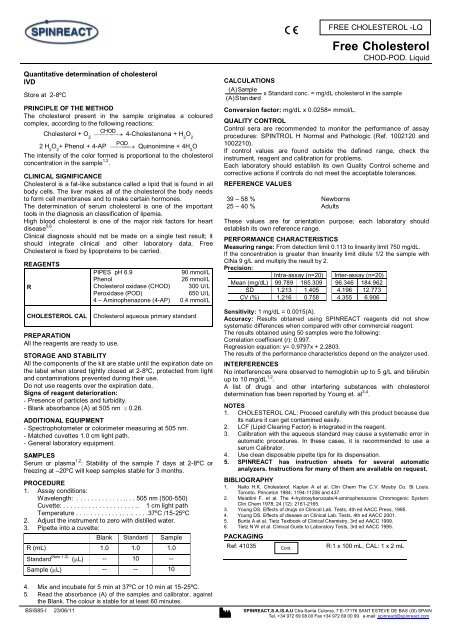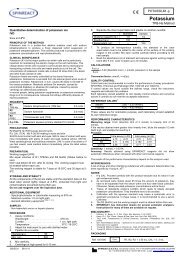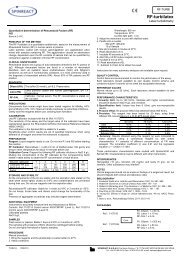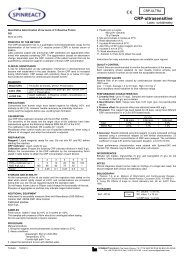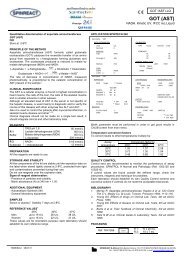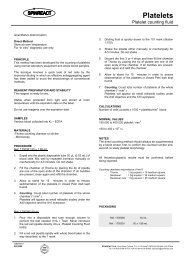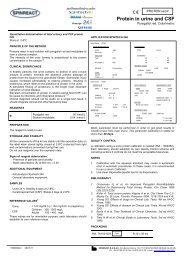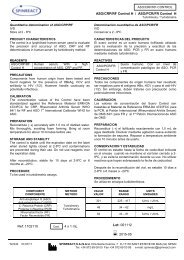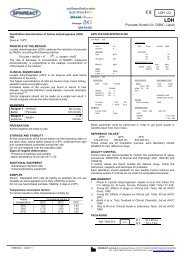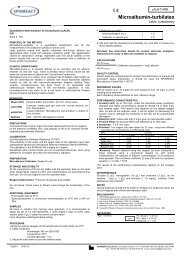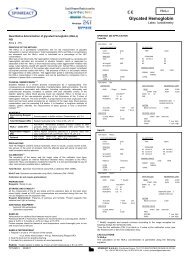Free Cholesterol
Free Cholesterol - Spinreact
Free Cholesterol - Spinreact
You also want an ePaper? Increase the reach of your titles
YUMPU automatically turns print PDFs into web optimized ePapers that Google loves.
FREE CHOLESTEROL -LQ<br />
<strong>Free</strong> <strong>Cholesterol</strong><br />
CHOD-POD. Liquid<br />
Quantitative determination of cholesterol<br />
IVD<br />
Store at 2-8ºC<br />
PRINCIPLE OF THE METHOD<br />
The cholesterol present in the sample originates a coloured<br />
complex, according to the following reactions:<br />
CHOD<br />
<strong>Cholesterol</strong> + O 2<br />
4-Cholestenona + H 2<br />
O 2<br />
POD<br />
2 H 2<br />
O 2<br />
+ Phenol + 4-AP Quinonimine + 4H 2<br />
O<br />
The intensity of the color formed is proportional to the cholesterol<br />
concentration in the sample 1,2 .<br />
CLINICAL SIGNIFICANCE<br />
<strong>Cholesterol</strong> is a fat-like substance called a lipid that is found in all<br />
body cells. The liver makes all of the cholesterol the body needs<br />
to form cell membranes and to make certain hormones.<br />
The determination of serum cholesterol is one of the important<br />
tools in the diagnosis an classification of lipemia.<br />
High blood cholesterol is one of the major risk factors for heart<br />
disease 5,6 .<br />
Clinical diagnosis should not be made on a single test result; it<br />
should integrate clinical and other laboratory data. <strong>Free</strong><br />
<strong>Cholesterol</strong> is fixed by lipoproteins to be carried.<br />
REAGENTS<br />
R<br />
CHOLESTEROL CAL<br />
PREPARATION<br />
All the reagents are ready to use.<br />
PIPES pH 6.9<br />
Phenol<br />
<strong>Cholesterol</strong> oxidase (CHOD)<br />
Peroxidase (POD)<br />
4 – Aminophenazone (4-AP)<br />
90 mmol/L<br />
26 mmol/L<br />
300 U/L<br />
650 U/L<br />
0.4 mmol/L<br />
<strong>Cholesterol</strong> aqueous primary standard<br />
STORAGE AND STABILITY<br />
All the components of the kit are stable until the expiration date on<br />
the label when stored tightly closed at 2-8ºC, protected from light<br />
and contaminations prevented during their use.<br />
Do not use reagents over the expiration date.<br />
Signs of reagent deterioration:<br />
- Presence of particles and turbidity.<br />
- Blank absorbance (A) at 505 nm 0.26.<br />
ADDITIONAL EQUIPMENT<br />
- Spectrophotometer or colorimeter measuring at 505 nm.<br />
- Matched cuvettes 1.0 cm light path.<br />
- General laboratory equipment.<br />
SAMPLES<br />
Serum or plasma 1,2 : Stability of the sample 7 days at 2-8ºC or<br />
freezing at –20ºC will keep samples stable for 3 months.<br />
PROCEDURE<br />
1. Assay conditions:<br />
Wavelength: . . . . . . . . . . . . . .. . . 505 nm (500-550)<br />
Cuvette: . . . . . . . . . . . . . . . . . . . . .. 1 cm light path<br />
Temperature . . . . . . . . . . . . . . . .. . . . .37ºC /15-25ºC<br />
2. Adjust the instrument to zero with distilled water.<br />
3. Pipette into a cuvette:<br />
Blank Standard Sample<br />
R (mL) 1.0 1.0 1.0<br />
Standard (Note 1-2) ( L) -- 10 --<br />
Sample ( L) -- -- 10<br />
CALCULATIONS<br />
(A)Sample<br />
x Standard conc. = mg/dL cholesterol in the sample<br />
(A)Stan dard<br />
Conversion factor: mg/dL x 0.0258= mmol/L.<br />
QUALITY CONTROL<br />
Control sera are recommended to monitor the performance of assay<br />
procedures: SPINTROL H Normal and Pathologic (Ref. 1002120 and<br />
1002210).<br />
If control values are found outside the defined range, check the<br />
instrument, reagent and calibration for problems.<br />
Each laboratory should establish its own Quality Control scheme and<br />
corrective actions if controls do not meet the acceptable tolerances.<br />
REFERENCE VALUES<br />
39 – 58 % Newborns<br />
25 – 40 % Adults<br />
These values are for orientation purpose; each laboratory should<br />
establish its own reference range.<br />
PERFORMANCE CHARACTERISTICS<br />
Measuring range: From detection limit 0.113 to linearity limit 750 mg/dL.<br />
If the concentration is greater than linearity limit dilute 1/2 the sample with<br />
ClNa 9 g/L and multiply the result by 2.<br />
Precision:<br />
Intra-assay (n=20) Inter-assay (n=20)<br />
Mean (mg/dL) 99.789 185.309 96.346 184.962<br />
SD 1.213 1.405 4.196 12.773<br />
CV (%) 1.216 0.758 4.355 6.906<br />
Sensitivity: 1 mg/dL = 0.0015(A).<br />
Accuracy: Results obtained using SPINREACT reagents did not show<br />
systematic differences when compared with other commercial reagent.<br />
The results obtained using 50 samples were the following:<br />
Correlation coefficient (r): 0.997.<br />
Regression equation: y= 0.9797x + 2.2803.<br />
The results of the performance characteristics depend on the analyzer used.<br />
INTERFERENCES<br />
No interferences were observed to hemoglobin up to 5 g/L and bilirubin<br />
up to 10 mg/dL 1,2 .<br />
A list of drugs and other interfering substances with cholesterol<br />
determination has been reported by Young et. al 3,4 .<br />
NOTES<br />
1. CHOLESTEROL CAL: Proceed carefully with this product because due<br />
its nature it can get contamined easily.<br />
2. LCF (Lipid Clearing Factor) is integrated in the reagent.<br />
3. Calibration with the aqueous standard may cause a systematic error in<br />
automatic procedures. In these cases, it is recommended to use a<br />
serum Calibrator.<br />
4. Use clean disposable pipette tips for its dispensation.<br />
5. SPINREACT has instruction sheets for several automatic<br />
analyzers. Instructions for many of them are available on request.<br />
BIBLIOGRAPHY<br />
1. Naito H.K. <strong>Cholesterol</strong>. Kaplan A et al. Clin Chem The C.V. Mosby Co. St Louis.<br />
Toronto. Princeton 1984; 1194-11206 and 437.<br />
2. Meiattini F. et al. The 4-hydroxybenzoate/4-aminophenazone Chromogenic System.<br />
Clin Chem 1978; 24 (12): 2161-2165.<br />
3. Young DS. Effects of drugs on Clinical Lab. Tests, 4th ed AACC Press, 1995.<br />
4. Young DS. Effects of disease on Clinical Lab. Tests, 4th ed AACC 2001.<br />
5. Burtis A et al. Tietz Textbook of Clinical Chemistry, 3rd ed AACC 1999.<br />
6. Tietz N W et al. Clinical Guide to Laboratory Tests, 3rd ed AACC 1995.<br />
PACKAGING<br />
Ref: 41035<br />
Cont.<br />
.<br />
R:1 x 100 mL, CAL: 1 x 2 mL<br />
4. Mix and incubate for 5 min at 37ºC or 10 min at 15-25ºC.<br />
5. Read the absorbance (A) of the samples and calibrator, against<br />
the Blank. The colour is stable for at least 60 minutes.<br />
BSIS85-I 23/06/11 SPINREACT,S.A./S.A.U Ctra.Santa Coloma, 7 E-17176 SANT ESTEVE DE BAS (GI) SPAIN<br />
Tel. +34 972 69 08 00 Fax +34 972 69 00 99. e-mail: spinreact@spinreact.com
FREE CHOLESTEROL -LQ<br />
Colesterol libre<br />
CHOD-POD. Líquido<br />
Determinación cuantitativa de colesterol<br />
IVD<br />
Conservar a 2-8ºC<br />
PRINCIPIO DEL MÉTODO<br />
El colesterol presente en la muestra origina un compuesto coloreado<br />
según la reacción siguiente:<br />
CHOD<br />
Colesterol Libre + O 2<br />
4-Colestenona + H 2<br />
O 2<br />
POD<br />
2 H 2<br />
O 2<br />
+Fenol + 4-Aminofenazona<br />
Quinonimina + 4H 2<br />
O<br />
La intensidad del color formado es proporcional a la concentración de<br />
colesterol presente en la muestra ensayada 1,2 .<br />
SIGNIFICADO CLÍNICO<br />
El colesterol es una sustancia grasa presente en todas las células del<br />
organismo. El hígado produce naturalmente todo el colesterol que<br />
necesita para formar las membranas celulares y producir ciertas<br />
hormonas. La determinación del colesterol es una de las<br />
herramientas más importantes para el diagnóstico y clasificación de<br />
las lipemias. El aumento del nivel de colesterol es uno de los<br />
principales factores de riesgo cardiovascular 5,6 .<br />
El diagnóstico clínico debe realizarse teniendo en cuenta todos los<br />
datos clínicos y de laboratorio. El Colesterol libre es fijado por las<br />
lipoproteínas para ser transportado.<br />
REACTIVOS<br />
R<br />
CHOLESTEROL CAL<br />
PIPES pH 6.9<br />
Fenol<br />
Colesterol oxidasa (CHOD)<br />
Peroxidasa (POD)<br />
4 - Aminofenazona (4-AF)<br />
90 mmol/L<br />
26 mmol/L<br />
300 U/L<br />
650 U/L<br />
0,4 mmol/L<br />
Patrón primario acuoso de Colesterol<br />
PREPARACIÓN<br />
Todos los reactivos están listos para su uso.<br />
CONSERVACIÓN Y ESTABILIDAD<br />
Todos los componentes del kit son estables hasta la fecha de<br />
caducidad indicada en la etiqueta del vial, cuando se mantienen<br />
los viales bien cerrados a 2-8ºC, protegidos de la luz y se evita su<br />
contaminación. No usar reactivos fuera de la fecha indicada.<br />
Indicadores de deterioro de los reactivos:<br />
- Presencia de partículas y turbidez.<br />
- Absorbancias (A) del Blanco a 505 nm 0,26.<br />
MATERIAL ADICIONAL<br />
- Espectrofotómetro o analizador para lecturas a 505 nm.<br />
- Cubetas de 1,0 cm de paso de luz.<br />
- Equipamiento habitual de laboratorio.<br />
MUESTRAS<br />
Suero o plasma 1,2 . Estabilidad de la muestra 7 días a 2-8ºC y 3<br />
meses si se mantiene la muestra congelada (-20ºC).<br />
PROCEDIMIENTO<br />
1. Condiciones del ensayo:<br />
Longitud de onda: . . . . . . . . . . . . . . . 505 nm (500-550).<br />
Cubeta:. . . . . . . . . . . . . . . . . . . . . . . .. .1 cm paso de luz<br />
Temperatura . . . . . . . . . . . . . . . . . . . . . . . .37ºC /15-25ºC<br />
2. Ajustar el espectrofotómetro a cero frente a agua destilada.<br />
3. Pipetear en una cubeta:<br />
Blanco Patrón Muestra<br />
R (mL) 1,0 1,0 1,0<br />
Patrón (Nota1-2) ( L) -- 10 --<br />
Muestra ( L) -- -- 10<br />
4. Mezclar e incubar 5 min a 37ºC ó 10 min a 15-25ºC.<br />
5. Leer la absorbancia (A) del patrón y la muestra, frente al<br />
Blanco de reactivo. El color es estable como mínimo 60<br />
minutos.<br />
CÁLCULOS<br />
(A)Muestra<br />
x Conc. Patrón = mg/dL de colesterol en la muestra<br />
(A)Patrón<br />
Factor de conversión: mg/dL x 0,0258= mmol/L.<br />
CONTROL DE CALIDAD<br />
Es conveniente analizar junto con las muestras sueros control<br />
valorados:<br />
SPINTROL H Normal y Patológico (Ref. 1002120 y 1002210).<br />
Si los valores hallados se encuentran fuera del rango de tolerancia, se<br />
debe revisar los instrumentos, los reactivos y la calibración.<br />
Cada laboratorio debe disponer su propio Control de Calidad y<br />
establecer correcciones en el caso de que los controles no cumplan<br />
con las tolerancias.<br />
VALORES DE REFERENCIA<br />
39 – 58 % Recién nacidos<br />
25 – 40 % Adultos<br />
Estos valores son orientativos. Es recomendable que cada laboratorio<br />
establezca sus propios valores de referencia.<br />
CARÁCTERÍSTICAS DEL MÉTODO<br />
Rango de medida: Desde el límite de detección 0,113 mg/dL hasta el<br />
límite de linealidad 750 mg/dL.<br />
Si la concentración de la muestra es superior al límite de linealidad, diluir<br />
1/2 con ClNa 9 g/L y multiplicar el resultado final por 2.<br />
Precisión:<br />
Intraserie (n=20) Ínterserie (n=20)<br />
Media (mg/dL) 99.789 185.309 96.346 184.962<br />
SD (mg/dL) 1.213 1.405 4.196 12.773<br />
CV (%) 1.216 0.758 4.355 6.906<br />
Sensibilidad analítica: 1 mg/dL = 0,0015 (A).<br />
Exactitud: Los reactivos SPINREACT no muestran diferencias sistemáticas<br />
significativas cuando se comparan con otros reactivos comerciales.<br />
Los resultados obtenidos con 50 muestras fueron los siguientes:<br />
Coeficiente de correlación (r): 0,9968.<br />
Ecuación de la recta de regresión: y= 0.9797x + 2.2803.<br />
Las características del método pueden variar según el analizador utilizado.<br />
INTERFERENCIAS<br />
No se han observado interferencias de hemoglobina hasta 5 g/L y<br />
bilirrubina hasta 10 mg/dL 1,2 . Se han descrito varias drogas y otras<br />
substancias que interfieren en la determinación del Colesterol 3,4 .<br />
NOTAS<br />
1. CHOLESTEROL CAL: Debido a la naturaleza del producto, es<br />
aconsejable tratarlo con sumo cuidado ya que se puede contaminar con<br />
facilidad.<br />
2. LCF(Lipid Clearing Factor) está integrado en el reactivo.<br />
3. La calibración con el Patrón acuoso puede dar lugar a errores<br />
sistemáticos en métodos automáticos. En este caso, se recomienda<br />
utilizar calibradores séricos.<br />
4. Usar puntas de pipeta desechables limpias para su dispensación.<br />
5. SPINREACT dispone de instrucciones detalladas para la aplicación<br />
de este reactivo en distintos analizadores.<br />
BIBLIOGRAFÍA<br />
1. Naito H.K. <strong>Cholesterol</strong>. Kaplan A et al. Clin Chem The C.V. Mosby Co. St Louis.<br />
Toronto. Princeton 1984; 1194-11206 and 437.<br />
2. Meiattini F. et al. The 4-hydroxybenzoate/4-aminophenazone Chromogenic<br />
System. Clin Chem 1978; 24 (12): 2161-2165.<br />
3. Young DS. Effects of drugs on Clinical Lab. Tests, 4th ed AACC Press, 1995.<br />
4. Young DS. Effects of disease on Clinical Lab. Tests, 4th ed AACC 2001.<br />
5. Burtis A et al. Tietz Textbook of Clinical Chemistry, 3rd ed AACC 1999.<br />
6. Tietz N W et al. Clinical Guide to Laboratory Tests, 3rd ed AACC 1995.<br />
PRESENTACIÓN<br />
Ref: 41035<br />
Cont.<br />
.<br />
R:1 x 100 mL, CAL: 1 x 2 mL<br />
BSIS85-E 23/06/11 SPINREACT,S.A./S.A.U Ctra.Santa Coloma, 7 E-171716 SANT ESTEVE DE BAS (GI) SPAIN<br />
Tel. +34 972 69 08 00 Fax +34 972 69 00 99. e-mail: spinreact@spinreact.com


